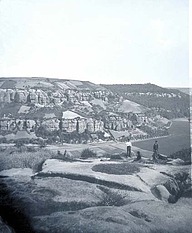Krátký, František
One of the most important Czech photographers and stereophotographs publishers of the Austro-Hungarian era. Captured in particular life in Bohemian and Moravian countryside, produced some&nbs
František Krátký belongs to the most important photographers and publishers of stereo photographs in the Czech lands from the times of the Austro-Hungarian era. On the list of work by photographer Krátký from the end of the 19th century we can find pictures of the Czech countryside and of people in exotic places.
He was born in the small town of Sadská, where his father František Vojtěch Krátký worked as a painter (of both pictures and houses), as well as having a printing business. During 1864-67, and again in 1870-72, he studied printing techniques with his father. He mentions 1878 as the official beginning of his photography career, although the first mention in the archives of the name “Krátký”, as being a photographer in Kolín, comes from August 1880.
In addition to portrait work, František Krátky photographed many landscapes and historical landmarks. Between 1885 and 1899, no other photographer travelled so comprehensively around the Bohemian and Moravian countryside. He concentrated primarily on stereo-photographs, which he began publishing from 1890, in the form of a pair of pictures, with a legend, pasted as original photographs onto cartboards. He emphasized the role of his pictures as teaching aids for learning to know about one's homeland.
With his camera he travelled through many foreign countries, obtaining some of his pictures from abroad by exchange, or by buying them from other photographers. Besides the Austro-Hungarian lands he visited the Balkans, Italy, Switzerland, Russia, Germany, and France. He obtained a stirring testimony from his stay in Russia during the spring of 1896, where he was a photographer on a special permit during the Czar's coronation. In the trade with foreign pictures he basically had no rival in the Czech lands. Krátký also published photos from the USA and Japan taken by other people, mainly by Czech explorer E. S. Vráz.
In April 1898, in his forty-sixth year, František Krátký married twenty-year-old Anna Pospíšilová in Nové Dvory, and he began a new life, where he travelled less, and concentrated more on publishing the photographs he had already collected. He focused on enlarging his business towards printing photographs. In October 1899, Krátký gained permission to “make zincographical or phototype plates, together with the existing photographical trade”, which meant that he could distribute photographs more effectively and in greater numbers. He also purchased land in a Kolín suburb, and during the year 1900, he set up what he called his “Photochemographical works”. This included a villa, and a building with a photo studio and workshop for zincography, phototypy, and lithography.
As well as original stereo photographs, his establishment published also coloured slides, stereoscopic and general postcards, and thematic notebooks with educational texts. He also published various occasional prints, with promotional materials forming an important component. He advertised the delivery of printing blocks “on zinc and copper”, and for three-colour printing, delivery of drawings and photographs as copy, making of stereo photographs and viewing glasses, sale of own photos from home and abroad, and a “studio for photographic portraits and paintings in oil”.
His advantage was his ability to integrate on a professional level, “all inclusive”. He could take an advertising picture in the studio (or an outside photo); modify the picture, as well as add text; and print it in black-and-white or colour. In its time, his was a very progressive understanding of photographical services.
His establishment reached its peak around 1909. In 1911, František Krátký had an eye operation, and his portrait studio in the town square was leased out. The illness, together with a crisis in the portrait photography business, as well as his general existential difficulties, led to his sale of the Photochemographical business in April 1913. František Krátký died in Kolín in May 1924, aged seventy-three. After coming of age, his son Jiří (born in 1901) commenced to work in the portrait studio.
The thematic breadth of his work places Krátký among the most important of Czech photographers. When looking through his work, it is interesting to notice the number of ordinary people in the photographs. We could even call him a photographer of the Czech countryside, although that does not mean he did not photograph towns and their memorabilia. He also tried to liven up these photographs of monuments by having some figures in the foreground, which by creating another theme plan achieved also an increase of the spatial effect when viewed. Even on pictures from abroad, he accomplished successfully what we could globally call the ability to bring together the ordinary with the special or bizarre. He held to a view that a country is characterized by its people. The very centre of his photographic creativity was the person.
By the breadth and testimony of his photography, František Krátký - along with his contemporary Bruner-Dvořák, the pioneer of journalistic photography - was one of the few Czechs of the Austro-Hungarian era to earn the title of being a truly “European” photographer.
Literature: P. Scheufler: František Krátký. Český fotograf před 100 lety. Baset, Praha 2004.


































